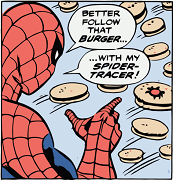|
ninepints posted:I broke something again. I've got this model Why are you sticking "this" in front of all your constructors? Anyway, double check you used new when you make that 'location' object. Which, by the way, the name location could get you into trouble if you are having trouble with this being set to the window, and your habit of throwing 'this' in front of everything, for obvious reasons. Not using new will cause this to point at the window. If you ddi use new then check you don't have nested this contexts. The first this will point at what you think (generally) but any other this in a nested function will point back out to the root / head object. That's why the 'self = this' hack / trick is used in JS so frequently. EDIT: try taking the 'this' off the this.Blah.prototype.blarg = function () stuff; that could be creating that nested function context which would repoint it. Lumpy fucked around with this message at 00:26 on Jan 12, 2012 |
|
|
|

|
| # ? May 16, 2024 04:47 |
|
Nope, that's not it. JS passes the this object according to syntax. o.f(); passes 'o' as the this object. var f = o.f; f(); passes the global object as the this object. The former is known as a qualifying call, the latter is known as an unqualifying call. If you have a modern browser, var f = o.f.bind(o); f(); should fix it. If you don't, you can use closures and Function.prototype.apply to help solve it: code:
|
|
|
|
Lumpy posted:Why are you sticking "this" in front of all your constructors? Anyway, double check you used new when you make that 'location' object. Which, by the way, the name location could get you into trouble if you are having trouble with this being set to the window, and your habit of throwing 'this' in front of everything, for obvious reasons. Not using new will cause this to point at the window. Definitely added the "new" keyword. I was using "this" since the constructors are inside separate main model/view objects and I wanted them to be visible to the controller, although I could make the constructors private and add accessor methods instead. Suspicious Dish posted:Nope, that's not it. JS passes the this object according to syntax. That'd probably be the issue, I'll try it out now. edit: It's working! Thanks for the help. Safari didn't support bind but jQuery.proxy saved the day. 205b fucked around with this message at 04:12 on Jan 12, 2012 |
|
|
|
*New Problem I keep getting an error on this code. I'm guessing it doesn't like the php inserted into the javascript? Error is: unterminated string literal I've tried putting double quotes in the php variables but i get more errors. code:stoops fucked around with this message at 22:29 on Jan 12, 2012 |
|
|
|
stoops posted:*New Problem You might want to post the entire expression - it got cut off.
|
|
|
|
stoops posted:*New Problem I'm assuming that you accidentally forgot to copy the rest of the line of code, but in the portions that are there the strings are malformed. When it hits the first single quote in 'Observation' it ends the string, so everything afterwards is junk that causes a syntax error. Put double quotes around your strings instead. If you still have errors after doing that, there are other problems in the part that didn't get pasted. Having PHP code inside your strings is fine (though it's not going to be executed obviously) as long as you're careful about quotes, backslashes, etc.
|
|
|
|
Gordon Cole posted:I'm assuming that you accidentally forgot to copy the rest of the line of code, but in the portions that are there the strings are malformed. When it hits the first single quote in 'Observation' it ends the string, so everything afterwards is junk that causes a syntax error. Put double quotes around your strings instead. I did what you said and it worked. Thanks. stoops fucked around with this message at 17:06 on Jan 13, 2012 |
|
|
|
I'm looking for a way to filter results in a <select> input in a form that is similar to how some sites filter states/provinces when you select a country. Basically I am going to have two drop boxes and the <options> in the second drop box are determined by what the user picks in the first drop box. I have no idea how to do this or what to even Google so hopefully someone here can lead me in the right direction. If jQuery has a plugin or something that already does this then that would save me from rewriting something.
|
|
|
|
IT Guy posted:I'm looking for a way to filter results in a <select> input in a form that is similar to how some sites filter states/provinces when you select a country. Don't know if this one works, but the word you are looking for is, "chained selects" http://www.appelsiini.net/2010/jquery-chained-selects Edit: but have you considered turning off and on your computer?
|
|
|
|
Strong Sauce posted:Don't know if this one works, but the word you are looking for is, "chained selects" Ah perfect, this will get me on the right path. Strong Sauce posted:
Figured it out, it wasn't plugged in 
|
|
|
|
Okay, everyone is familiar with SA's timg BBcode command, yes? Well, I'm trying to introduce something similar to a wiki I manage. I'm basically completely inept with JavaScript, but after bumbling around I finally found some code that would suit my purposes:code:I haven't the slightest idea how to do that. Anyone care to help me out? The Man From Melmac fucked around with this message at 21:41 on Jan 30, 2012 |
|
|
|
Benjamin Black posted:Okay, everyone is familiar with SA's timg BBcode command, yes? Well, I'm trying to introduce something similar to a wiki I manage. I'm basically completely inept with JavaScript, but after bumbling around I finally found some code that would suit my purposes: document.getElementsByName("smallImagesNameGoesHere") will return an array containing all the elements with the desired class name. You can assign this to a variable, then iterate over the array and give each element the desired onClick(); method. If you want it to happen after the page loads, just define a function that does the above, then add the call to the body tag as an onLoad function: code:code:code:
|
|
|
|
Thanks for the help so far! Two things though: 1. I can't really change the body tag. Am I able to use window.onload = function(){STUFF} instead? (Edit: I realize it might already be compatible, but I want to get my reply out here while I fiddle around with the code.) 2. What would I have to change to have this apply to id's instead of classes? The Man From Melmac fucked around with this message at 21:59 on Jan 30, 2012 |
|
|
|
1. Probably 2. var someElement = document.getElementById('someId');
|
|
|
|
Okay. Here's what I did. I seemed to have failed miserably, it's not working. I'm still trying to get it working as we speak, I'm sure it's something I did wrong.code:code:
|
|
|
|
Element ID's must be unique in valid HTML. I wouldn't recommend using ID as a way to classify resized images. I'd just get all img tags, and then test the class from there. You can use something like this: code:jQuery makes all this stuff a lot simpler and more robust, which is why I tend to use it for everything. peepsalot fucked around with this message at 23:15 on Jan 30, 2012 |
|
|
|
peepsalot posted:Element ID's must be unique in valid HTML. I wouldn't recommend using ID as a way to classify resized images. Still can't get it to work. Maybe it'd be easier if I just showed you guys my test page, just keep in mind that I can't modify the body tag for the wiki I'm using this for. On another note, if you wanted me to use jQuery instead, that'd be fine, I can embed javascript files into the wiki without difficulty (I already have in fact). The Man From Melmac fucked around with this message at 14:32 on Nov 22, 2012 |
|
|
|
Benjamin Black posted:Still can't get it to work. Maybe it'd be easier if I just showed you guys my test page, just keep in mind that I can't modify the body tag for the wiki I'm using this for. Using jQuery, this code: code:So then you could have lots of images like this: code:Lumpy fucked around with this message at 16:13 on Nov 22, 2012 |
|
|
|
e: nevermind
peepsalot fucked around with this message at 16:35 on Nov 22, 2012 |
|
|
|
peepsalot posted:woops, onclick should be all lowercase. Sorry my JS is a little rusty. Okay, that fixed it. Awesome. I'll try the jQuery stuff out shortly. I seem to have run into another issue, though. It looks like if a page has multiple "window.onload = function()"s, like say, one on the page and one on the sidebar, only one of them will run for some reason. Annoying. Thanks for the all help so far. The Man From Melmac fucked around with this message at 23:27 on Jan 30, 2012 |
|
|
|
Benjamin Black posted:Okay, that fixed it. Awesome. I'll try the jQuery stuff out shortly. I seem to have run into another issue, though. It looks like if a page has multiple "window.onload = function()"s, like say, one on the page and one on the sidebar, only one of them will run for some reason. Annoying. Yeah, that's why that form of event registration sucks. And the proper way is a pain because IE does everything different from the real browsers. So yeah, use jquery. the shortcut way to do onload in jquery is just this: $(function() { //do stuff here });
|
|
|
|
Benjamin Black posted:Okay, that fixed it. Awesome. I'll try the jQuery stuff out shortly. I seem to have run into another issue, though. It looks like if a page has multiple "window.onload = function()"s, like say, one on the page and one on the sidebar, only one of them will run for some reason. Annoying. Writing code:window is an object. onload is a member of window. Specifically, window.onload is a member that should have a pointer to a function assigned to it. So, if you assign to it multiple times, the only one that is going to exist is the last one that was assigned to it. Assigning your listeners in HTML is generally a poor decision for multiple reasons, least of which is the problem you are running in to right now. In HTML you can only have a single listener/handler for any event. The proper way to handle this is: code:
|
|
|
|
ComptimusPrime posted:Writing Well of course it's not the proper way to do things, it doesn't work after all! I'm just trying to work within the constraints of this wiki software. Anyway... I'm trying out jQuery now. I've never used it before, so obviously this is completely wrong and broken: The Man From Melmac fucked around with this message at 14:33 on Nov 22, 2012 |
|
|
|
http://jsbin.com/atebuy/
|
|
|
|
peepsalot posted:http://jsbin.com/atebuy/ There we go. Perfect. Thanks. Glad I wasn't as off as I thought at the very least.
|
|
|
|
Hey guys, me again. This time I have a (hopefully) simple question. I'm looking into using the innerHTML command to once again get around some restrictions of the wiki software. So I found this: http://www.w3schools.com/htmldom/tryit.asp?filename=try_changetext Very easy and all, but I need to do this by class rather than ID. But when I try the following code... code:
|
|
|
|
Benjamin Black posted:Hey guys, me again. This time I have a (hopefully) simple question. I'm looking into using the innerHTML command to once again get around some restrictions of the wiki software. So I found this: Use the getElementsByClassName method instead.
|
|
|
|
Poop Delicatessen posted:Use the getElementsByClassName method instead. I already tried that. Didn't make a difference.
|
|
|
|
Poop Delicatessen posted:Use the getElementsByClassName method instead. Or don't because IE up to and including IE 8 do not support it. http://www.quirksmode.org/dom/w3c_core.html This is why libraries are necessary, because loving IE hosed UP THE WEB AGAIN. Benjamin Black posted:Hey guys, me again. This time I have a (hopefully) simple question. I'm looking into using the innerHTML command to once again get around some restrictions of the wiki software. So I found this:
|
|
|
|
peepsalot posted:getElementsByName returns an array of elements. arrays don't have an innerHTML property. You'll need to loop through that. So I'm going to have to do more on-load shenanigans with jQuery I assume?
|
|
|
|
Benjamin Black posted:So I'm going to have to do more on-load shenanigans with jQuery I assume? It should work ok, if you access the innerHTML of an element in the returned array. Also, if you are trying to grab an element by name, you'll want to give it a name attribute. There is a difference between getElementsByName, getElementsByClassName, and getElementsByTagName. peepsalot fucked around with this message at 23:19 on Jan 31, 2012 |
|
|
|
peepsalot posted:Not necessarily. That wasn't the point I was making at all. Okay, well, in the spirit of learning, I spent a while trying to do this myself, doing a lot of reading on w3schools and using the Tryit Editor for my experiments, but sadly I didn't really get anywhere without resorting to having a function that runs when the page loads. So, here's what I want to know. code:I feel like 'function that runs when the page loads' are the training wheels I need to stop using as soon as possible. The Man From Melmac fucked around with this message at 00:20 on Feb 1, 2012 |
|
|
|
Benjamin Black posted:Okay, well, in the spirit of learning, I spent a while trying to do this myself, doing a lot of reading on w3schools and using the Tryit Editor for my experiments, but sadly I didn't really get anywhere without resorting to having a function that runs when the page loads. Well, you have to make sure your DOM is loaded (well, technically just those elements, but close enough) before you can manipulate them. Then, since you are using a CLASS and not an ID, you will affect all H1 tags inside ALL elements that have the class name 'banana'. You can get fancy and limit it to DIV tags with the class, but the point stands. What I would do is to use jQuery, and do this: code:* you cannot manipulate an element until it exists in the DOM (Document Object Model). For example: code:* Ids are UNIQUE. Only one element in the whole DOM should have a specific Id. * when you get elements by Id, you get ONE element back (a la getElementById) If you hosed up and gave two elements the same Id, you only get one back. * Classes are to designate many elements as sharing some property or semantic. Many elements in the DOM can have the same class. * When you get elements by class, you get a COLLECTION of elements, even if there happens to only be one. For example, getElementsByClassName returns an Array, regardless of how many elements there are with the class. * Same goes for other ways of getting DOM elements... if it's possible to have more than one on the page, you get returned a collection. You sure can have more than one LI in a page, so getElementsByTagName() returns a collection. Note the plural in getElements for tag, tagName, className, etc. That tells you you are going to get a collection back from that method. * when you get back a collection of elements, you need to manually iterate through the collection to manipulate the individual elements. Even if there's only one. You can use a for loop or fancy pants map or forEach or whatever, but you have to go in and get the stuff in the collection to change it. Lumpy fucked around with this message at 00:32 on Feb 1, 2012 |
|
|
|
Benjamin Black posted:I feel like 'function that runs when the page loads' are the training wheels I need to stop using as soon as possible. The browser parses the html document in order, from top to bottom, building a DOM tree full of html element nodes as it goes. If your script block exists in the html before the browser has parsed a particular element, then that element doesn't exist as far as javascript is concerned. Using onload events delays the execution of javascript so that it occurs after the DOM tree has been completely built. Most people from what I've seen(myself included) prefer to keep all script blocks and script includes at the top of the page, in the head, mostly as a code convention. Since none of the DOM tree has been built at this point, it's necessary to use onload events. Some people recommend just putting all your javascript at the very bottom of the page anyways (must still be inside the body tag), which has the added advantage of avoiding the DOM loading issues. peepsalot fucked around with this message at 00:39 on Feb 1, 2012 |
|
|
|
Yes, I'm aware it would affect all h1 tags inside any 'banana' class, I pointed out in the post you quoted that this is assuming there is only one banana class. I do understand most of what you said already, id's being unique, the elements needing to be loaded before they're affected, etc. Correct me if I'm wrong, but doesn't that jquery function you showed me need to be called by something before it actually does anything? I've been trying to avoid functions that get automatically called when the page finishes loading because it tends to make the page loading look a bit ugly. Like, I really like the thumbnail solution that was talked about earlier, but for a split second, you see the images at their full size before they're shrunk down (yeah, I can probably make a workaround for that, but I'm just giving an example why I don't want to do it here, because I have limited control over the order in which things get loaded). So, what if there was this instead: code:
|
|
|
|
Also, yeah, I just realized I phrased some things poorly in my last reply, particularly about the page loading. What I meant to say is, the page is probably going to load in such a way that you can see the original text for a split second if I use a function that runs when the page load completes, which is why I want to avoid doing that. Edit: Yeah, just in case I went ahead and tried this method and it's just as I feared, it takes like a full second for the text to change. The Man From Melmac fucked around with this message at 01:44 on Feb 1, 2012 |
|
|
|
Benjamin Black posted:Yes, I'm aware it would affect all h1 tags inside any 'banana' class, I pointed out in the post you quoted that this is assuming there is only one banana class. You can't assume there will only be one of a class. That's what made me think you don't understand classes vs. IDs. My jQuery function is called when the DOM is ready. For the new HTML you posted, you do document.getElemenyById('banana').firstChild.innerText = "hurf drurf"; or something along those lines. I forget if firstChild is the right name or if its a property or method, but you get the gist. If code executing on DOM ready takes over a second to run, the page you are working with has some serious problems. Lumpy fucked around with this message at 01:49 on Feb 1, 2012 |
|
|
|
Lumpy posted:You can't assume there will only be one of a class. That's what made me think you don't understand classes vs. IDs. quote:For the new HTML you posted, you do document.getElemenyById('banana').firstChild.innerText = "hurf drurf"; or something along those lines. I forget if firstChild is the right name or if its a property or method, but you get the gist. gently caress. It's not actually the first (or last) child of an id I'm trying to modify. I didn't think that was even an option when I presented the example. Edit: It doesn't seem to be working anyway. code:code:code:quote:If code executing on DOM ready takes over a second to run, the page you are working with has some serious problems. The Man From Melmac fucked around with this message at 02:36 on Feb 1, 2012 |
|
|
|
Okay, nevermind, I figured out what I needed to do. Thanks for the help.
|
|
|
|

|
| # ? May 16, 2024 04:47 |
|
Paragraph elements (<p>..</p>) can't have 'block-level' elements inside them (like h1). Use a div element instead. What's happening is when the browser builds the DOM tree and gets to the p tag it sees there's an invalid block level element inside it and pulls it out, making it a sibling of the <p> element. (or something to that effect. In other words, by the time the JS was executed the <h1> node was no longer a child of the <p> node). Orbis Tertius fucked around with this message at 05:59 on Feb 1, 2012 |
|
|
























